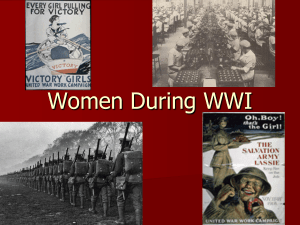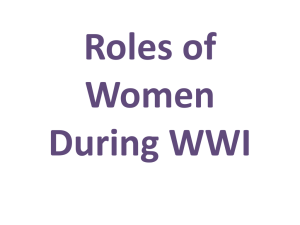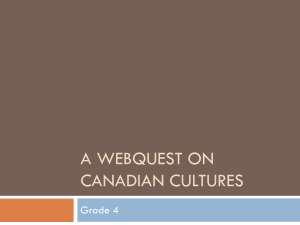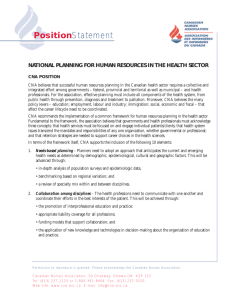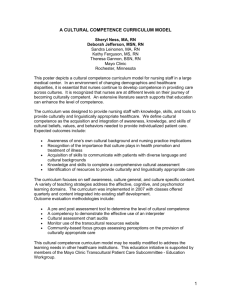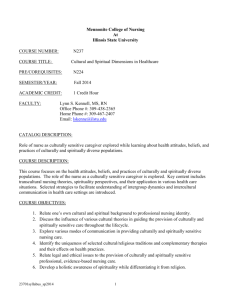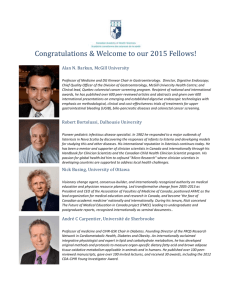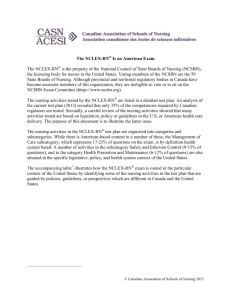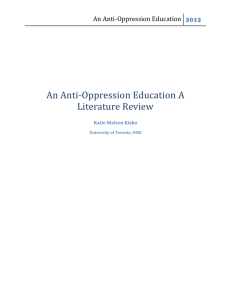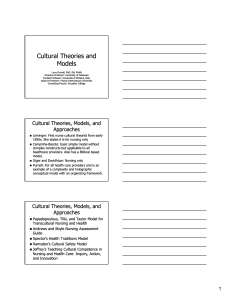Table 1 Perspective/ Framework Goal or Key Tenets Theorists
advertisement
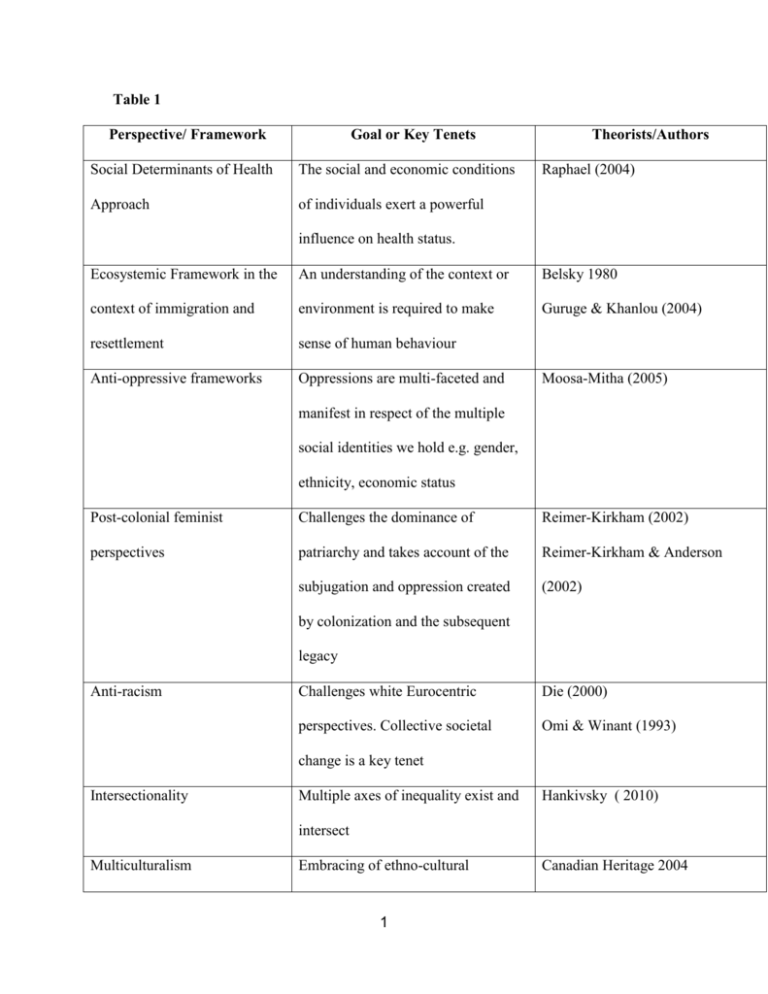
Table 1 Perspective/ Framework Goal or Key Tenets Social Determinants of Health The social and economic conditions Approach of individuals exert a powerful Theorists/Authors Raphael (2004) influence on health status. Ecosystemic Framework in the An understanding of the context or Belsky 1980 context of immigration and environment is required to make Guruge & Khanlou (2004) resettlement sense of human behaviour Anti-oppressive frameworks Oppressions are multi-faceted and Moosa-Mitha (2005) manifest in respect of the multiple social identities we hold e.g. gender, ethnicity, economic status Post-colonial feminist Challenges the dominance of Reimer-Kirkham (2002) perspectives patriarchy and takes account of the Reimer-Kirkham & Anderson subjugation and oppression created (2002) by colonization and the subsequent legacy Anti-racism Challenges white Eurocentric Die (2000) perspectives. Collective societal Omi & Winant (1993) change is a key tenet Intersectionality Multiple axes of inequality exist and Hankivsky ( 2010) intersect Multiculturalism Embracing of ethno-cultural 1 Canadian Heritage 2004 difference whilst acknowledging the right to retain a unique cultural identity Table 1 references Raphel D: Social Determinants of Health: Canadian Perspectives. Toronto, ON: Canadian Scholars’ Press; 2004. Belsky J: Child maltreatment: an ecological integration. American Psychologist 1980, 35:320-335. Guruge S, Khanlou N: Intersectionalities of influence: researching the health of immigrant and refugee women. Canadian Journal of Nursing Research 2004, 36:32-47. Hankivsky O, Reid C, Cormier R, Varcoe C, Clark N, Benoit C, Bratman S: Exploring the promises of intersectionality for advancing women's health research. International Journal for Equity in Health 2010, 9:5 doi:10.1186/1475-9276-9-5 Moosa-Mitha M: Situating anti-oppressive theories within critical and difference-centred perspectives. In Research as Resistance. Critical, Indigenous and Anti-oppressive Approaches. Edited by Broen L, Strega S. Toronto, ON: Canadian Scholars’ Press; 2005: 37-72. Reimer-Kirkham S, Anderson J: Postcolonial nursing scholarship: from epistemology to method. Advances in Nursing Sciences 2002, 25:1-17. Reimer-Kirkham S: The politics of belonging and intercultural health care. Western Journal of Nursing Research 2002, 25:762-780. Dei G: Toward an anti-racism discursive framework. In Power, Knowledge and Anti-Racism Education: A Critical Reader. Edited by Dei G, Calliste A. Halifax, NS: Fernwood; 2000: 23-40. 2 Omi M, Winant H: On the theoretical concept of race. In McCarthy C, Crichlow W eds Race, identitiy and Representation. New York, Routledge; 1993: 3-10. Canadian Heritage: Annual Report on the Operation of the Canadian Multicultural Act, 20022003. Ottawa, Ontario; 2004. Available at http://dsp-psd.pwgsc.gc.ca/Collection/CI95-12003E.pdf, accessed July 5, 2011. 3 Table 2: Constructs and dimensions of identified tools/models Name of Ethno – cultural nursing assessment tool/model The Process of Cultural Competence in the Delivery of Healthcare Services Model Giger-Davidhizar Transcultural Assessment (GDTAM) Year Developed Constructs and Dimensions 1994 Cultural competence as a process involve the integration of Cultural awareness, Cultural skill, Cultural knowledge, cultural encounters and cultural desire. 1988 Davidson,J.U.; Reigier,T.;Boos,S. Family Cultural Heritage Assessment Tool (FAMCHAT) 1997 Kim-Godwin, W.S.Clarke, P.N.; Barton, L. The Culturally Competent Community Care model (CCCC) 2001 Narayanasamy,A. Assessment , 1999 Communication, Cultural negotiation and compromise, Establishing respect and rapport, Sensitivity, Safety (ACCESS )model The Purnell Model 1995 for Cultural Competence The Giger-Davidhizaar Transcultural Assessment Model help in assessing differences between people in cultural groups by considering Communication, space, social organization,time, enviromental control and biological variations. The tool is designed as a qualitative assessment tool with open-ended questions on a number of variables, Beliefs system, Language, Influence of acculturation, Formal and, informal group membership. The proposed constructs of culturally competent care by this model are: caring, cultural sensitivity, cultural knowledge, and cultural skills in community-based settings with focus on ethnic populations. The model delineates: communication as the crux of cultural care, while nurses are required to make efforts to become aware of others cultures by negotiation and compromise while establishing respect and rapport and showing sensitivity to all aspects of patients’ needs. Authors Campinha- Bacote Davidhizar,R.; Giger,J.N.; Hannenpluf,L.W. Purnell, L. 4 This model has twelve domains which flow from general to more specific cultural phenomena: heritage, communication, family roles and organization, workforce issues, biocultural ecology, high-risk behaviours, nutrition, pregnancy and childbearing practices, death rituals, spirituality , and health care practice health care practitioner Papadopoulos, Tilki & Taylor Leininger, M. The Papadopoulos, Tilki and Taylor model for developing cultural competence The Sunrise model 2004 Cultural awareness, cultural knowledge, cultural sensitivity and cultural competence 1955 Popular model of transcultural nursing which focus on: Technological factors, religious & philosophical factors , kinship and social factors, cultural vallises and life ways,political and legal factors, economic factors and educational factors within the individual, families, groups communities and institutions. Cultural care preservation/maintenance, Cultural care accommodation/negotiation and Cultural care repatterning / restructuring and finally the worldview of the provider. 5 6

